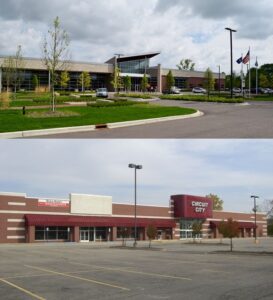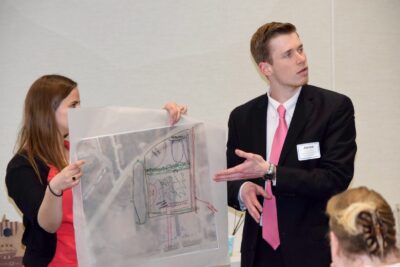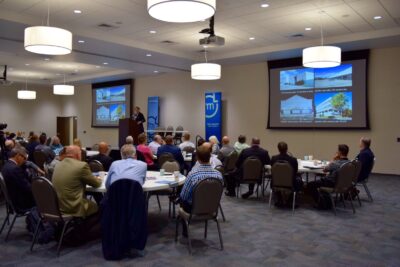
Big box stores can have second lives, as Westland’s Circuit City to City Hall renovation, completed in 2014, demonstrates.
In 2012, the City of Westland set aside plans to build a new city hall–the long-needed replacement to a ’60s vintage building that was literally rotting from a high water table–in favor of buying and renovating an abandoned Circuit City on Warren Road. This choice saved nearly $5 million (a third of the original budget!) while netting twice as much square footage, allowing the city to consolidate its cable channel, Youth Services, economic development, and other functions into a single building. As a bonus, the city has one fewer vacant and blighted property to monitor.
This success story made Westland City Hall the perfect venue for the League’s first Suburban Summit, with teams from suburban communities around southeast Michigan gathering to discuss strategies for helping their neighborhoods and commercial corridors mature and adapt to changing societal needs. (A second summit was held the next day at Fifth/Third Ballpark in Comstock Park for West Michigan communities.)
Georgia Tech’s Ellen Dunham-Jones (watch her TED talk!) joined architect and Birmingham City Commissioner Mark Nickita to lead discussion of the possibilities for updating the commercial corridors and neighborhoods of the last half century to meet the growing demand for walkable communities and a wider variety of housing choices: as families with school-aged children become a smaller share of households, communities must offer some draw beyond the formula of a good school district and single-family homes with enough bedrooms. This formula worked from the 1950s through the 1980s, when Baby Boomers and Millennials were growing up, but we know that the preferences of those demographics have shifted to living in places with more, well, place to them.
While those post-war suburbs are starting without some of the assets that support placemaking in older downtowns and neighborhood nodes, they have a huge asset in their huge, single-owner commercial parcels. As Nickita pointed out, a vacant Kroger and its expanse of cracking parking lot may offer the same acreage as all of downtown Plymouth, or the entire Mackinac Island townsite, with relatively few complications standing in the way of implementing a new strategy. A single large commercial parcel can therefore support the creation of an entire new walkable, mixed-use neighborhood center, without any changes or disruption required in the surrounding area.
This is by no means a fast or easy process, but a committed city with engaged private development partners can combine complete streets, green infrastructure, good urban design, careful market research, and updated policies to provide their residents–new and old–with the sense of place that will serve them for the next few generations.

